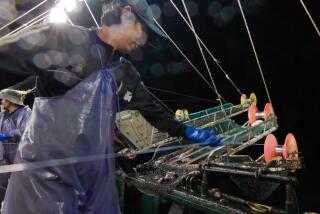Scientists Study How to Save Billfish
- Share via
MIAMI — It’s a rough day on the Gulf Stream. The 67-foot Calanus bobs in 4-foot waves as Stacy Luthy and Jerry Ault reel in a sailfish.
This type of billfish grows up to 6 feet long, not including its long pointy beak. They’re a prized catch for sport fishermen.
Ault and Luthy are not out for sport, and the sailfish they have caught is not nearly so big. Measuring just under a half-inch, it can easily be placed on a fingertip.
For the two University of Miami researchers, it’s a keeper.
They wash the tiny fish from the net and place it under a microscope, hoping to learn more about juvenile billfish to help ensure that the species has a future.
Researchers are looking at the spawning habits of billfish-- swordfish, spearfish, sailfish and blue and white marlin. They’re learning where they breed, how quickly they grow and how they survive until they become adults. That’s when they swim the ocean as primary predators. Even sharks find them too big and too fast to consider hunting them.
The information is critical to help rebuild overfished species. If the fish are threatened, so are the commercial and sportfishing industries that need them.
Researchers hope to use their findings to make recommendations to fishing regulators about quotas, including the possibility of banning fishing in spawning areas.
Only humans can be blamed for the decline in billfish populations, said Ault, a biologist and associate professor at Miami.
“These guys are the lions of the open ocean. They’re the King Kong predator fish,” he said, noting that marlin grow up to 18 feet and swordfish up to 12 feet.
Billfish numbers today are estimated at only 5% of their historical population, Ault said. Although it’s difficult to determine how many exist, Ault said their numbers are in the “hundreds of thousands.”
The fish spawn primarily in warm waters off the southeast U.S. coast, the Caribbean and Gulf of Mexico. Adults can be found in warm waters around the world.
While the main target of some commercial fishermen may be tuna or swordfish, other billfish become unintentional victims, or bycatch.
Fishermen set the lines, which stretch for miles, with baited hooks dangling. Marlin, sailfish and spearfish are hooked along with the sought-after catch. Ideally, fishermen release billfish and juvenile swordfish, which can’t be brought ashore. The problem is, many die on the line or shortly after they’re unhooked.
Ault said nearly all adult billfish that die are killed by long-line fishing.
“We’re at a level where we might be at fishing extinction,” he said. “It may be at the point where they won’t recover even if we stop fishing.”
University researchers have learned that the waters off South Florida are “ground zero” for billfish spawning.
Just a few miles from Miami Beach, they find the ocean crawling with billfish larvae. The tiny fish have a distinct beak and back fin even at 3/4 inch in length.
Researchers scoop them up with nets dragged from behind their floating laboratory, sometimes catching as many as 50 in a single tow.
“They’re just beautiful, beautiful replicas of the adults,” Ault said.
They grow quickly in their first year, swordfish and sailfish reaching about 4 feet and marlins reaching about 8 feet.
Chances are one in a million that a juvenile will survive to become an adult that fishermen consider a prize.
Sport and recreational fishermen say they also want to take steps to make sure the fish that put food on their tables aren’t destroyed.
“The industry is well aware of the lessons that have been taught with other species,” said Linda Candler, spokeswoman for the National Fisheries Institute in Arlington, Va., which represents the fishing industry. “No one wants to fish themselves out of business.”
Nelson Beideman, executive director of the Blue Water Fishermen’s Assn. of Barnegat Light, N.J., said fishermen are studying ways to reduce the bycatch.
His group, which represents long-line fishermen, is also working with sportfishing groups to push legislation that would ban long-line fishing in “hot spot” spawning areas. That area would be as large as California and stretch from the Carolinas border into the Florida Keys and include parts of the Gulf of Mexico.
The proposal seeks up to $24 million to pay commercial fishermen active in the spawning areas to give up their licenses and retire, Beideman said.
“It’s a shame because these are good fishermen and they’ve done a good job and it’s the freshest, best swordfish you could possibly buy,” he said.
Boat captains who line South Florida docks to take sportfishermen out for the chance to hook a marlin or sailfish say their industry has also changed.
Not long ago, sportfishermen would haul in a marlin and have it smoked or turned into a trophy. Now the pressure is on to let it go.
“We say, ‘Don’t you want your kids or your grandkids to be able to catch them?’ ” said captain Dawn Megelsberg, who operates out of Miami. “The replica mounts are just as beautiful as the real thing.”
Charter captain Dennis Forgione said he rarely gets an argument when he tells fishermen to let a billfish go--if it’s still alive.
“We still catch well over 100 sailfish a year, and all of ours are let go. But there are some that are caught that are stone cold dead,” he said. “I always say that if it has any life at all, let it go.”
Many recreational fishermen point fingers at long-line fishermen for dwindling billfish numbers.
“Ninety-eight percent of all the sailfish that are killed in U.S. waters are killed and thrown away on long lines,” said Mike Leech, president of the International Game Fishing Assn. in Fort Lauderdale. “It’s had a severe impact on sports fishing.”
Beideman said long-liners and sportfishermen have the same interests and use the same basic tools.
“It’s the exact same hook manufactured on the same machine,” he said. “That hook with the same bait in the warm waters is going to catch the same species, whether it’s hooked to a long line or to a rod and reel. It’s rather discouraging that there’s a discrimination. . . . One’s a criminal and the other’s had a lucky day.”
More to Read
Sign up for Essential California
The most important California stories and recommendations in your inbox every morning.
You may occasionally receive promotional content from the Los Angeles Times.










